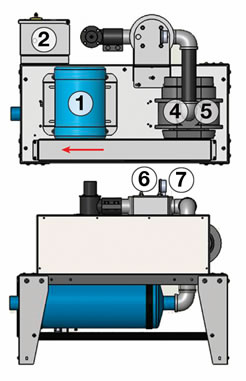Basic Startup / Troubleshooting Checklist - Vacuum Pump
- Check direction of rotation of the pump / motor. If incorrect, change phase.
- Check that motor amperage draws are correct. If not, check wire terminations at motor starter. Also check resistance across motor voltage legs, and between each leg and ground.
- No resistance indicates shorted windings.
- An open circuit between voltage legs indicates damaged windings.
- Check belts for proper tension and alignment, as well as wear and tear.
- Check blower for wear and tear, such as bearing play, leaking seals excess backlash.
- Check oil level in Positive Displacement and Claw pumps. Replace if necessary per Instruction Manual.
NOTE: Regen pumps do not require oil changes but they should have their bearings lubed per instruction manual.
- Check pump and system vacuum capacity:

a) Remove vacuum line from inlet to the cyclone (or central dust collector).
b) Partially cap off the cyclone inlet with a rigid, flat object (wood, sheet metal, etc.).
c) Begin operating the pump, and begin to slowly block more air at the cyclone inlet to increase the vacuum being drawn. The vacuum gauge should be able to reach maximum inches Hg vacuum for the pump (see pump instruction manual). This will let you know the pump is sealed properly. Confirm the high vacuum relief valve opens to prevent pulling more than maximum rated vacuum.- If the vacuum level fails to reach maximum, there is an air leak at the dust collector or pump. Check the seal on the dump can on the cyclone, the filter housing lid seal at the pump, the vacuum breaker valve, (verify it has air 85 to 100 psi), and all piping connections.
- If the valve doesn’t open, you have a system vacuum leak. Check for any open lines, open system vacuum valves (Station T Valve or lid mounted External Fill Valve), or loss of compressed air to system vacuum valves.
- Check the vacuum while the system is conveying material. Normally, the pump vacuum gauge should read between 4” Hg vacuum and up to 1” Hg less than the pump relief point. Typically, vacuum<4” Hg indicates a vacuum leak or no movement of material. Vacuum >relief point can be caused by:
- Line clogging where too much material is in the conveying line without the proper air mixture.
- Stations are being overfilled.
- The filter on the vacuum chamber or at the pump may be clogged.
- The station vacuum valve may not be opening (check control settings and the valve itself).



